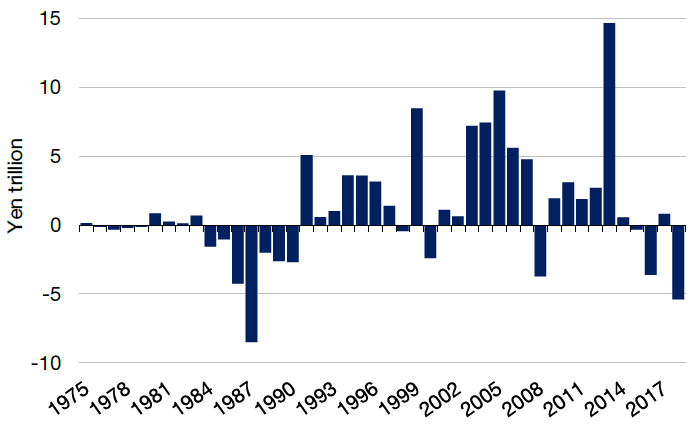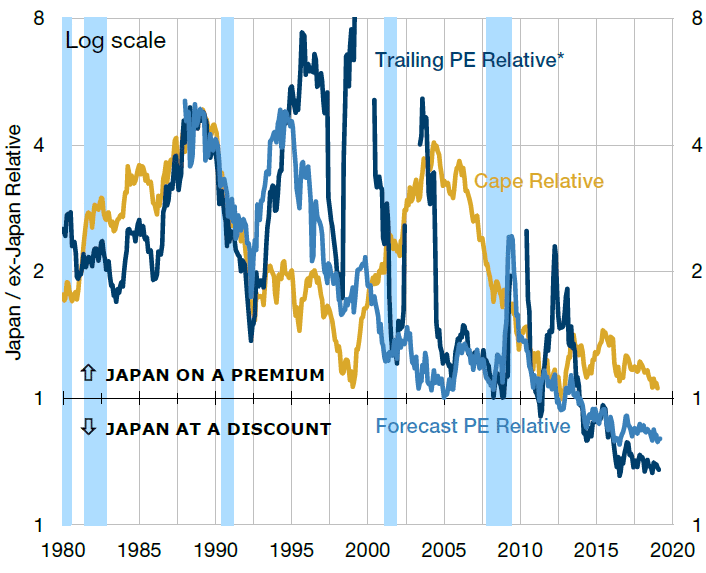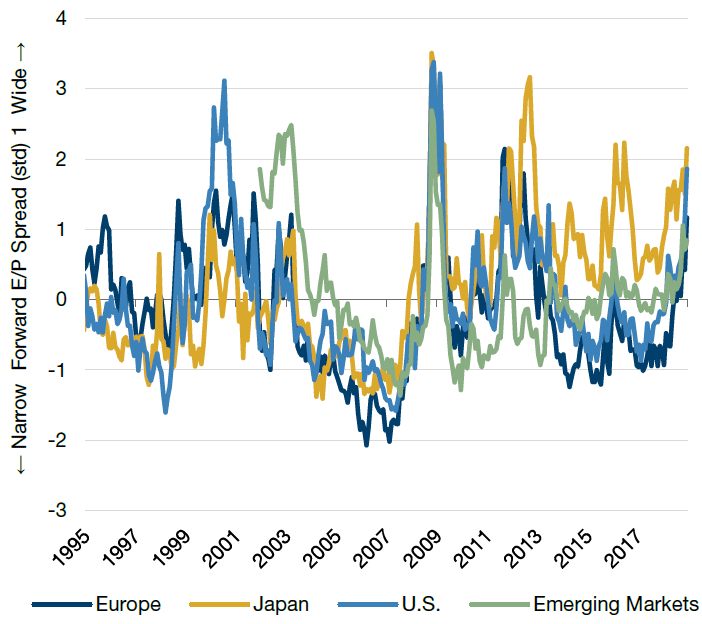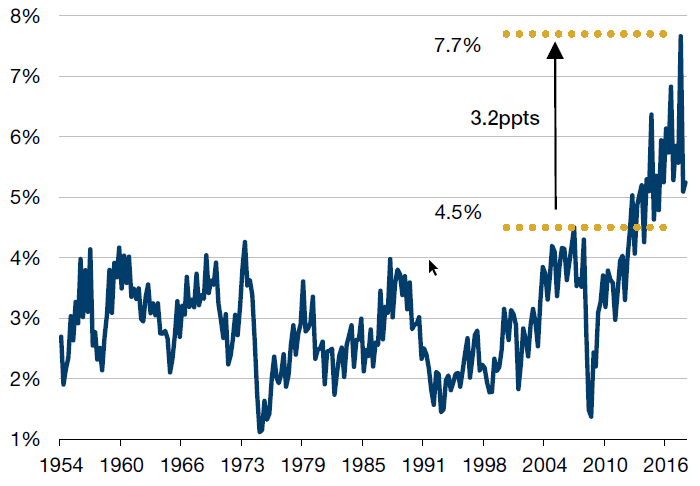Introduction
As of the end of March 2019, the Japanese equity market represents the second-largest country weight of the MSCI World index, at 8%. This is a far cry from the 45% that it represented at the peak of its financial bubble in 1989, when the cyclically adjusted price-to-earnings (‘PE’) ratio reached 100x.
Indeed, Japan has now turned into a forgotten market, in our view: the highest amount of foreign selling in 30 years – 6 trillion yen – occurred in 2018 (Figure 1).
However, we believe the country is still an important market for global investors and warrants attention for four main reasons: compelling valuation (suggesting a potential beta opportunity), encouraging signs at the corporate level, supportive global macro trends and domestic macro trends that seem unlikely to get worse.
Figure 1. Foreign Net Buying of Japanese Stocks

Source: CLSA, Bloomberg, Japan Exchange Group. Data up to the week ended 14 December 2018.
The Beta Opportunity
Japan is on its knees when measured by performance and valuation. The MSCI Japan is trading at its lowest versus other developed markets since 1972.1 The same is true if its PE ratio is compared with the rest of the world (Figure 2). We also find that the valuation spread between cheap and expensive companies is wider in Japan than anywhere else in the world (Figure 3). Finally, based on our Composite Valuation Indicator (‘CVI’), Japan reached a rare 2 standard deviation ‘buy’ signal at the end of 2018, which has historically been followed by average performance of +9% over the subsequent 12 months. This all suggest there may well be a beta opportunity in Japan for global investors.
Figure 2. Relative Valuation of Japanese Equities

Source: Minack Advisors; as of March 2019. All series are MSCI Japan relative to MSCI Developed Market ex-Japan. * No data when Japan EPS is negative.
Figure 3. Global Valuation Spreads

Source: Man Numeric; as of March 2019.
But do fundamentals point that way too?
Encouraging Signs at the Corporate Level
Japan’s low popularity, valuation and performance stands in sharp contrast to some positive fundamental developments, in our view. We are impressed with what is going on in the corporate sector.
First, profitability has increased in the last few years (Figure 4).
Figure 4. Corporate Japan Pretax Profit Margin (All Companies, Including Unlisted)

Source: CLSA, Japan MoF; as of March 2019.
Second, buybacks and dividends have both risen in the last few years: as of the end of March 2019, the dividend yield was level with the US at 2.5%, while buybacks increased to 7 trillion yen in 2018 from less than 1 trillion yen in 2009.2 Indeed, buybacks plus dividends now make up half of profits. Additionally, there is scope for more buybacks and dividends, as more than 50% of Japanese companies have net cash on their balance sheet, versus around 20% in Europe and the US.3
Third, there are more and more signs of corporate change, in part driven by the corporate governance code. There has been a first hostile takeover in over 12 years with Itochu / Descente and activist investors are increasingly influential. For instance, ValueAct has been able to appoint a board member at Olympus, Elliott Advisors are linked with buyback activity and some cross shareholdings are being unwound, such as with recent Bank of Kyoto initiatives. From here, some argue that the next step would be that companies use their balance sheets more and that workforce restructuring could be made easier through natural attrition as the work force ages.
Supportive Global Macro Trends
Historically, the best environment for Japanese equities to do well has been when global nominal growth improves, inflation rises and the US dollar is strong. We currently find support from all three angles.
First, as mentioned in ‘The Cavalry Arrives’, we are optimistic on the prospects for global growth. Second, while inflation is subdued globally, there are signs of labour inflation everywhere, including in Japan: voices supportive of new ways to generate inflation, such as Modern Monetary Theory or targeting average inflation allowing for some ’make-up’, are increasingly loud. If fully implemented, we anticipate these policies would succeed in creating inflation globally (For more on this, read
‘Battling Deflation’). Third, the yen has been weak; a yen below 104-106 should lead to positive earnings surprises, according to research by CLSA.
When margins and profitability were low, the correlation between a weak yen and a strong equity market was very high. Now that the corporate sector’s profitability is higher, it follows logically that the corporate sector depends less on yen weakness. We would even argue that Japanese equities can now move independently of the yen. While we do not think that is the most likely outcome, we do think the good outlook for Japanese equities would be changed only by a much stronger yen, not by a slightly stronger yen.
Domestic Macro Trends Seem Unlikely to Get Worse
We believe that those who overly focus on quantitative easing (‘QE’) and the upcoming consumption tax increase may well be focusing on the wrong issue. Since Shinzo Abe and Haruhiko Kuroda took the economic reins, central bank and fiscal policies have been important market drivers.
The Bank of Japan’s QE has now reached the stage where it is not clear what they could do next to step it up further, if required: the deposit rate is negative and yield curve control has been successful in keeping the 10-year rates around zero. Cutting these further would have negative side effects for the banking sector.
More buying of equities is a possibility. The BOJ already owns about half of the Japanese government bond market and 7% of the equity market; the Japanese Government’s Pension Investment Fund owns another 8%.4 BOJ’s balance sheet is 102% of the GDP as of March 2019, versus the European Central Bank at 41%, Bank of England at 29% and the Federal Reserve’s at 19%.5
Regarding fiscal policy, there is a history of very negative consequences when the consumption tax was raised in the past (1989, 1997, 2014) and a further rise is scheduled for later this year. However, this time around, the authorities are proceeding with more caution than before, offsetting this increase with fiscal easing mainly through lower education fees.
Furthermore, on a recent research trip to Japan, we found that senior policymakers are not complacent about the challenges that face Japan – including negative rates, demographics and the need for further restructuring – which we thought to be important and reassuring.
The Risks
Other than the general risks to global equity markets, we see two principal risks for Japan equities.
First and foremost, a stronger yen could spoil the positive outlook. The low valuation and the 4% current account surplus both argue for a stronger yen, while the continued QE argues for a weaker currency. Rather than forecasting yen strength, we believe that as long as the yen stays weaker than around 105 against the US dollar, the profit outlook is good.
The second risk relates to political leadership. Abe’s third and last term ends in October 2021 at the latest and Kuroda’s reign ends in 2023. Could policies become less business friendly after Abe and Kuroda? While we do not expect this, we will be watching closely. Other risks centre around the health of the banking sector: since 1994, the number of large banks decreased from 21 to five through consolidation, but the number of regional banks has stayed at 64. The threat of debt sustainability has also loomed for many years now.
Conclusion
While Japan received a lot of attention from global investors when Abenomics was introduced after 2012, we believe it has now turned into a forgotten market.
Indeed, the country warrants attention for four main reasons, in our view: compelling valuation (suggesting a potential beta opportunity), encouraging signs at the corporate level, supportive global macro trends and domestic macro trends that seem unlikely to get worse.
1. Source: MSCI; as of March 2019.
2. Source: Bloomberg; as of March 2019.
3. Source: CLSA; as of March 2019.
4. Source: Source: Bloomberg; as of March 2019.
5. Source: Bloomberg; as of March 2019.
You are now leaving Man Group’s website
You are leaving Man Group’s website and entering a third-party website that is not controlled, maintained, or monitored by Man Group. Man Group is not responsible for the content or availability of the third-party website. By leaving Man Group’s website, you will be subject to the third-party website’s terms, policies and/or notices, including those related to privacy and security, as applicable.